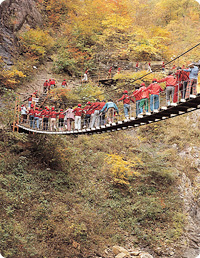National Park
Wolchulsan
Wolchulsan (South western region)While running along the Naju Yeongsangang river from the south tip of the vast plains of Honam, visitors can suddenly see a "stone mountain" standing alone in the field. Its name bears a lyric meaning "of the mountain that the moon rises from." It is generally accepted that the mountain was named Wolchul because its proximity to the West Sea makes it the first Korean peak to get moonlight. Wolchulsan became Korea's 20th national park in 1988. It is the smallest national park in Korea. It is located on the southern tip of the Korean peninsula and spans an area of only 56㎢. Although its area is small it is well known as the "Sogeumgang of Honam" because its scenery displays an endless horizon of steep slopes. Its superb view is often - and appropriately - summed up in the expression, "The unfolded Wolchulsan is Geumgangsan". Wolchulsan's rock-filled scenery has greatly contrasting faces - the views in the east contrast sharply with those of west, where one of the highest peaks Cheon-hwangbong sits. We can say that the east is full of great, tall, pillar-shaped rocky peaks, while the west is an exhibition hall of tall and short artistic rocky pagodas. As the rocky scenery is said to not only contain the feeling of eternity but also vary according to each visitor's particular angle of view Wolculsan's rocky scenery has become known as necessarily bearing one of the grandest sights imaginable to anybody. Through legend, we are told that 99 small and big temples were located within these rocky surrounds as backdrop. Long time ago people tended to worship rocks. Nowadays we can still see vestiges of people's faith and prayer over the "male" and "female" rocks that are scattered everywhere. One of the best-known legends in Wolchulsan pertains to a spiritual rock named "Yeongam." For this reason, the village just north of the mountain retains the name "Yeongam." According to the records of Donggukyeojiseungram there were three self-moving rocks in Wolchulsan. One was called Unmubong, and the others used to be under Dogap and Yongam. These moving rocks exhibited the same amount and direction of motion regardless of how many people pushed it what way. There is a rock with the inscription "Moving Stone" is under the second highest peak Gujeong-bong in Wolchulsan.






